Purchases made through links earn us a small commission, at no extra cost to you.
The Eiffel Lake hike in Banff National Park is a beautiful and diverse trail that offers stunning views of the Valley of the Ten Peaks, the iconic mountains that frame Moraine Lake.
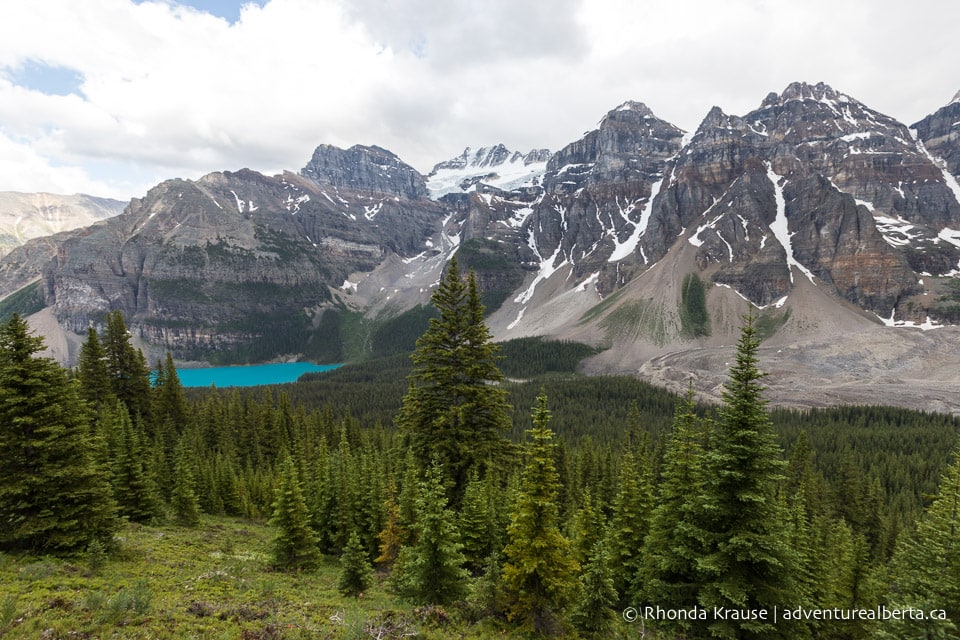
On route to the upper end of the Valley of the Ten Peaks, where Eiffel Lake sits, the trail passes through an area of closed forest before emerging onto an open slope with wildflower meadows and a panoramic view of the ten summits. For a longer hike, there’s the option to carry on past Eiffel Lake to Wenkchemna Pass.

Eiffel Lake Hike
Distance: 10.8- 11.2 km round trip (depending on how far you walk along the slope above Eiffel Lake)
Difficulty: Moderate
Elevation Gain: 443 m
Surface: Packed dirt with exposed rocks and roots, a section of scree
Trail Type: Out and back
Time: 3.5- 4.5 hours
Trailhead: Beside the lakeshore, just past the Moraine Lake Lodge

Eiffel Lake Trail Description
Like several other Moraine Lake hikes, the Eiffel Lake Trail starts at the north end of Moraine Lake, just beyond the Moraine Lake Lodge. It shares a trailhead with the Larch Valley hike, so you’ll see that on the sign along with distances of other hikes that begin here.

After a short 200 m walk along Moraine Lake, the trail splits at a junction of the Moraine Lakeshore Trail and Larch Valley Trail. Go right here to head to Eiffel Lake.
For roughly the next 2.4 km the Eiffel Lake trail follows the same course through the forest as the Larch Valley trail. This section of the Eiffel Lake hike is where most of the elevation gain happens, as the path continuously climbs through the trees.
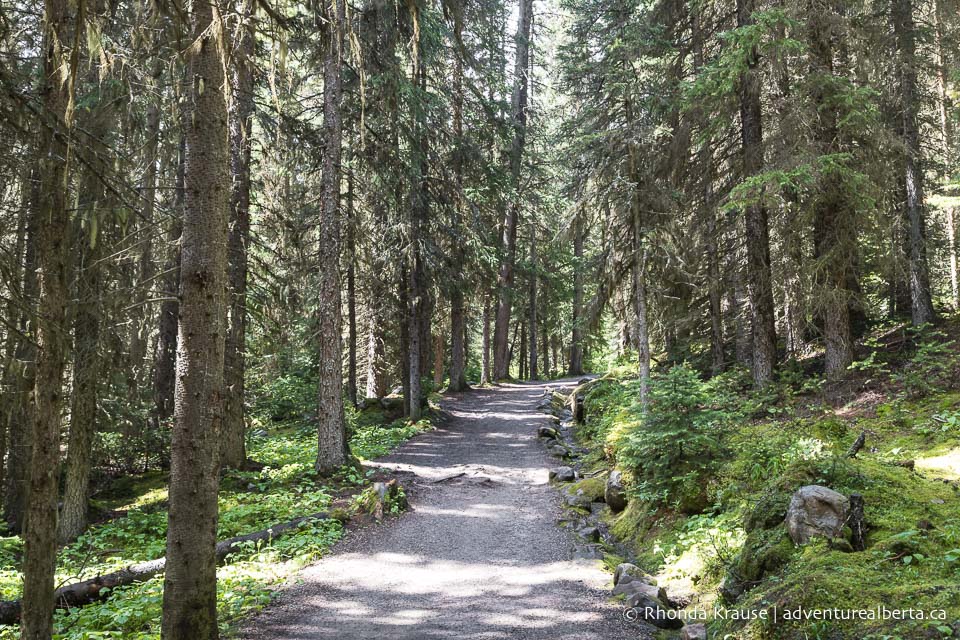
Not long after veering away from Moraine Lake, the trail reaches a short wooden bridge that crosses over a stream flowing down the hillside. The path then continues straight before eventually reaching a section of switchbacks.


As the trail zigzags up the steep slope, you get glimpses of Mount Fay and Fay Glacier where there are gaps between trees. Sometimes you can even see the turquoise water of Moraine Lake glistening brightly down below.
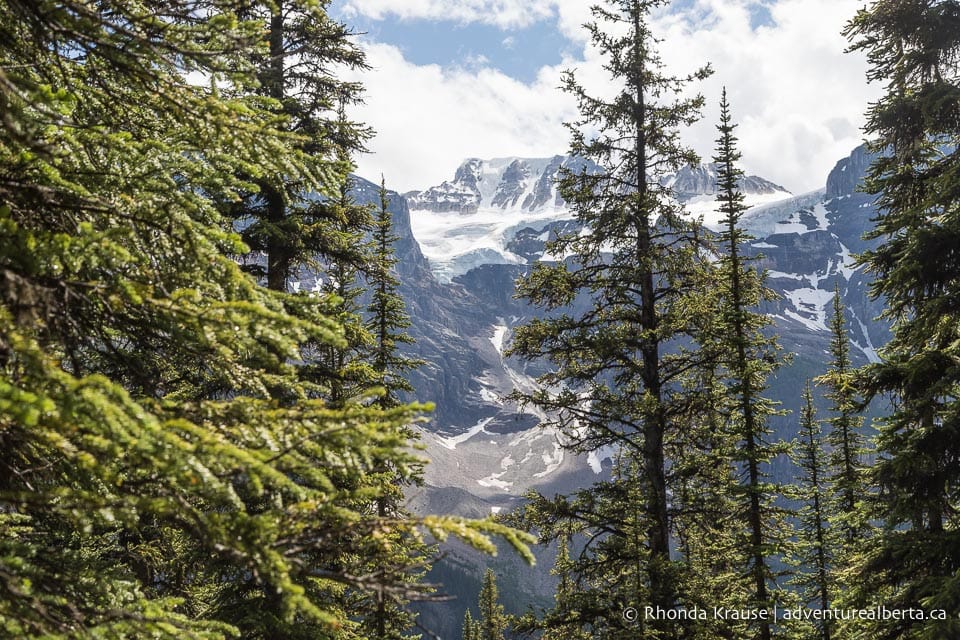

As exciting as it is to see the snow-covered peaks, these fleeting views are only a teaser for what’s to come further up the trail.
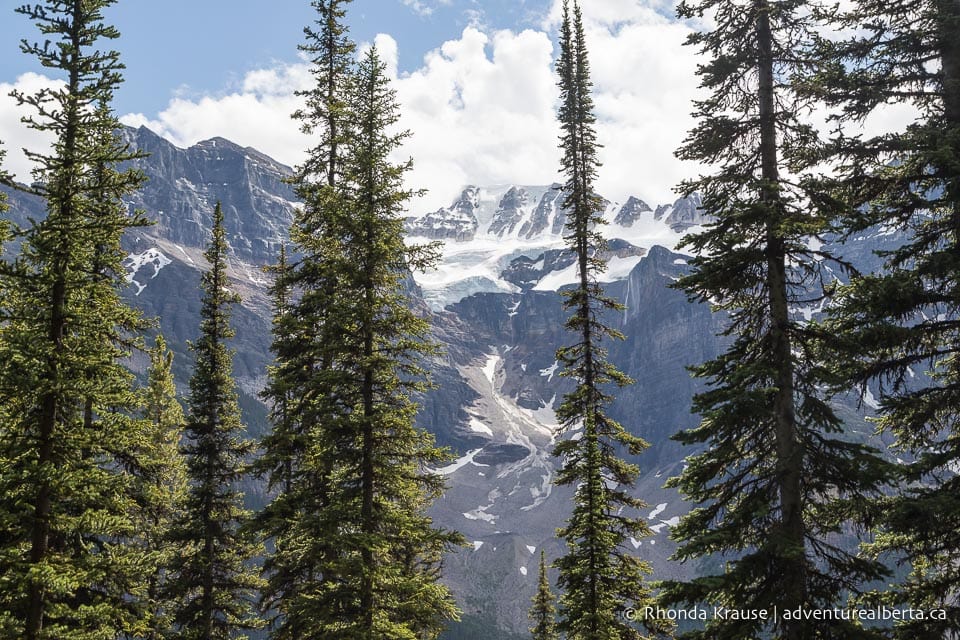
Once you reach the top of the switchbacks you’ll come to another intersection near the lower edge of Larch Valley. There’s a bench here if you need a rest and a trail sign with directions.

At the sign, keep left to get on Eiffel Lake Trail. After this point you’ll see fewer people since most choose to go right for Larch Valley.
For the remaining 3 km or so of the hike to Eiffel Lake there is little change in elevation. The trail continues through a section of forest where there are more views of Mount Fay and wildflowers growing beside the path.


Soon the trail exits the shelter of the forest and traverses across an open slope on the north side of the Valley of the Ten Peaks. This is the most scenic part of the hike because you can see the summits, the south end of Moraine Lake, and the rock-covered tongue of Wenkchemna Glacier.
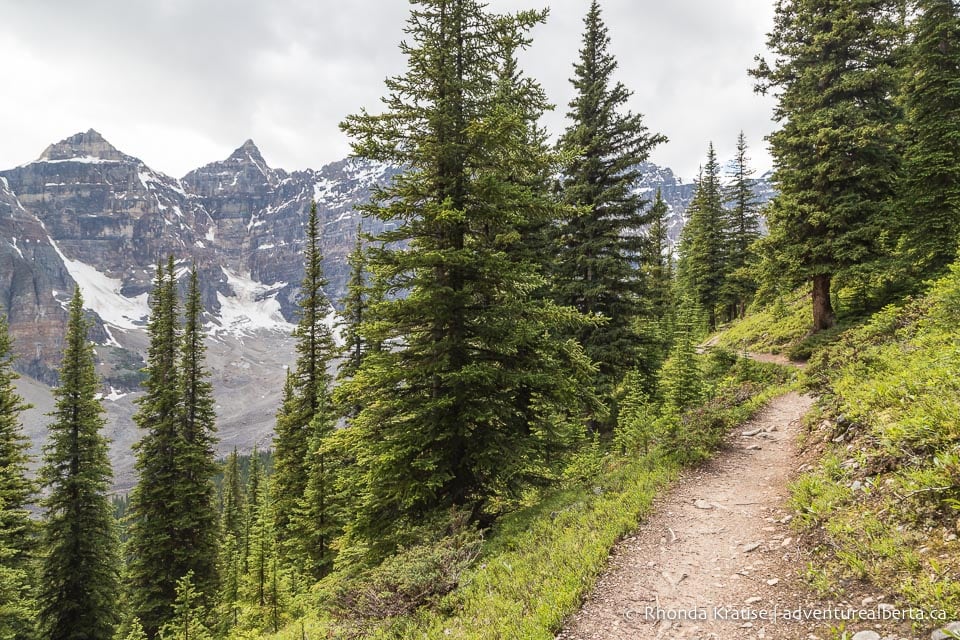

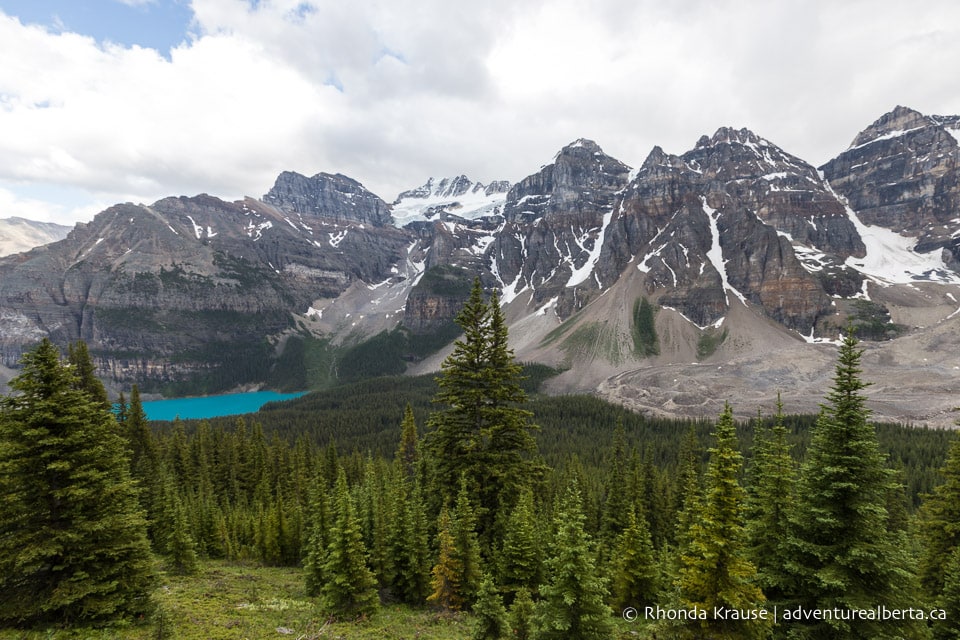
Continuing towards the end of the valley, you’ll pass through some flower-filled meadows and another small forested area. Unlike at the start of the hike, the trees only briefly conceal the views and soon the peaks are revealed once again.
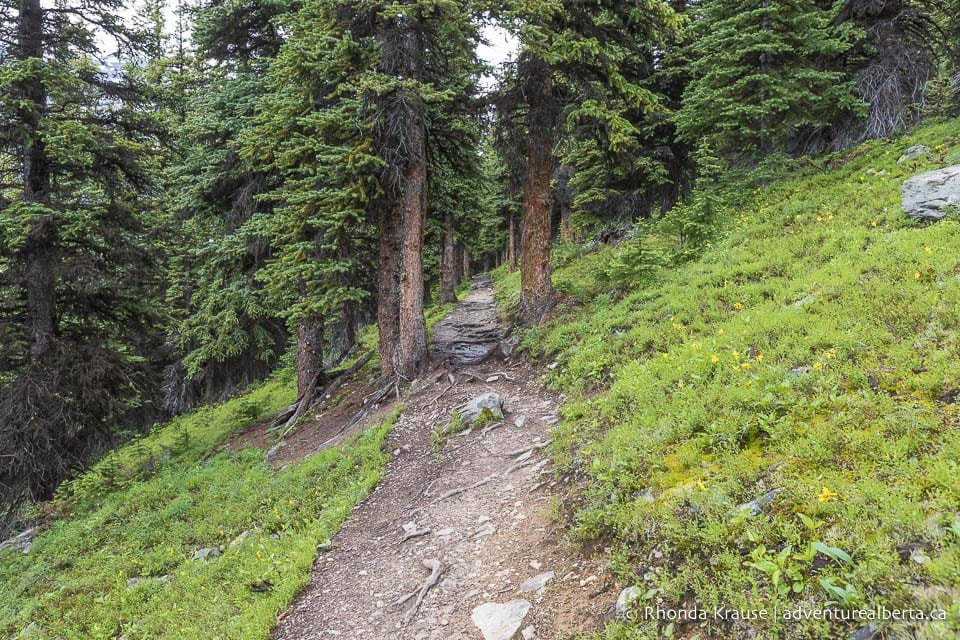


Further up the trail you’ll come to a wide open area that may have a snow field you have to cross. Even in late July (when these pictures were taken) there was still a fairly large patch of snow covering this section of trail.
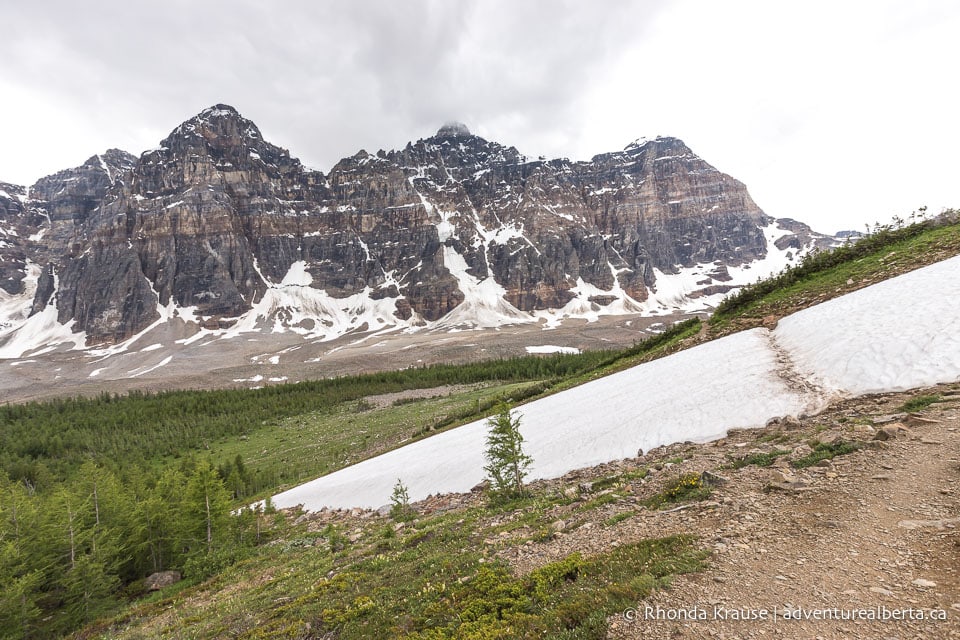
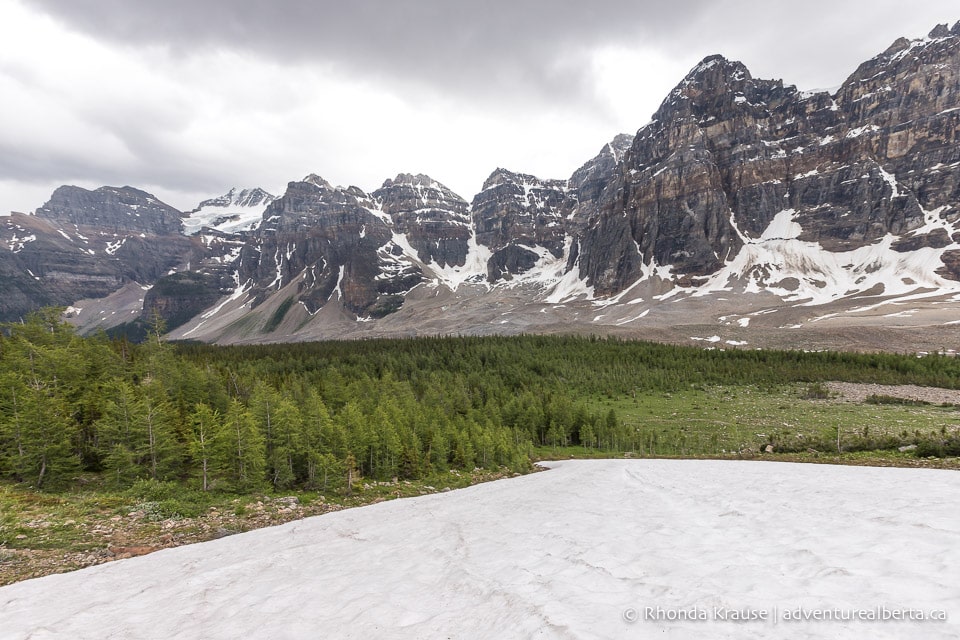
The final approach to Eiffel Lake requires crossing a scree-covered slope that overlooks the small lake.
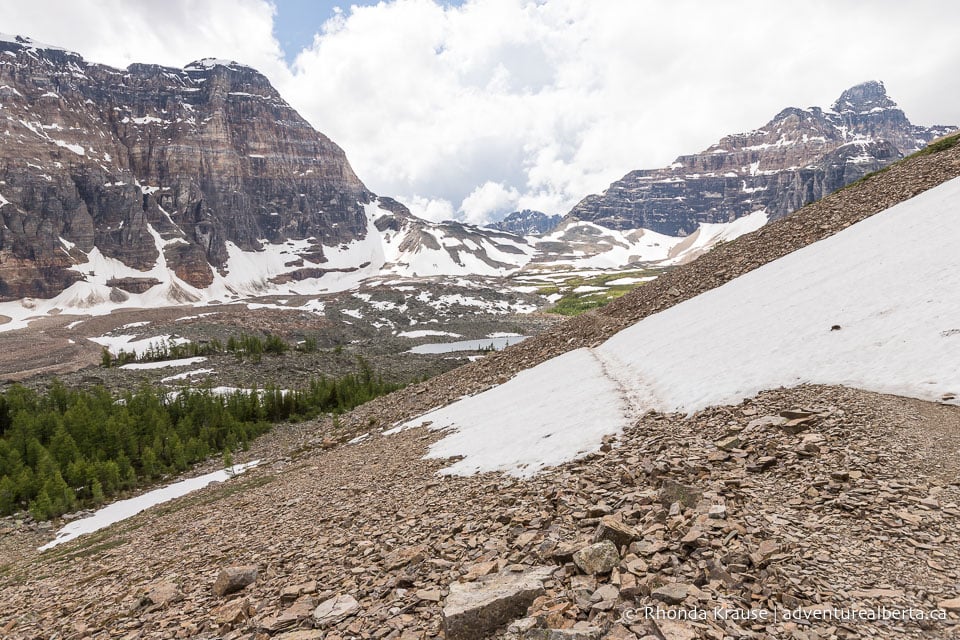
While the lake itself is nothing special, the surroundings sure are. Eiffel Lake is framed by rugged mountains, the Wenkchemna Pass, and rocky debris that broke off from Neptuak Mountain.

In fact, Eiffel Lake didn’t exist before the Neptuak Mountain rockslide created a basin that was then filled with meltwater from the snowfields at the head of the valley. Rockfall has also covered most of the Wenkchemna Glacier.
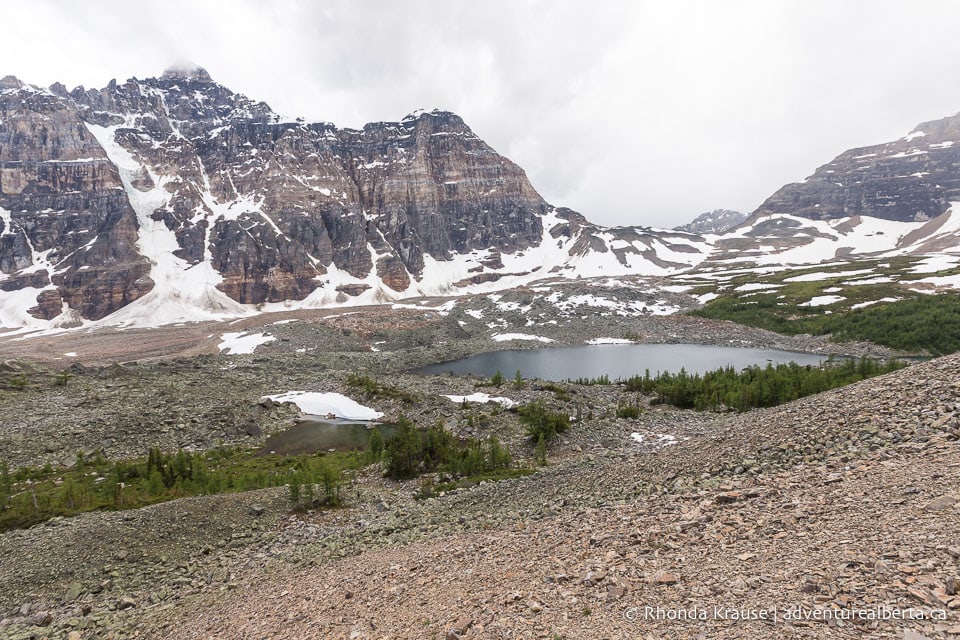
You can walk along the slope until you are satisfied with the view of Eiffel Lake, but if you make it to the far west end, where the larch trees are, there’s a nice vantage point for admiring Eiffel Lake with the Valley of the Ten Peaks.

There is no trail going down to the lake, so if you want a closer look you’ll have to maneuver over the broken rock.

At the end of the Eiffel Lake hike you can choose to go another 4 km or so up to Wenkchemna Pass, on the crest of the Great Divide, or turn around and head back the way you came. The weather changes quickly here, and snow flurries can happen even in the summer, so keep that in mind when making your decision.
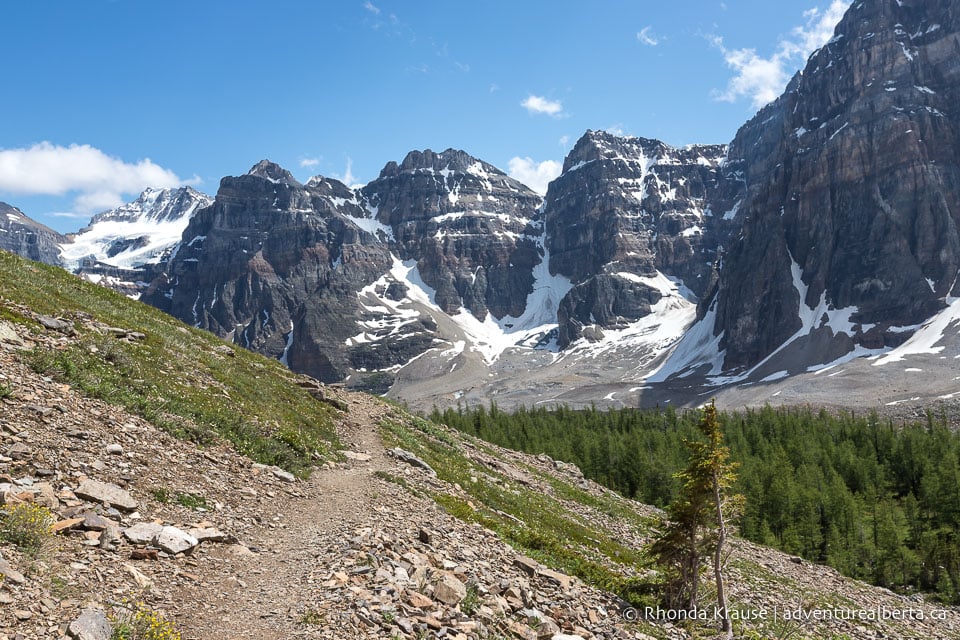
The return hike on Eiffel Lake Trail is just as enjoyable as the way in because now you get to see all the stunning scenery that was previously at your back. This slightly different perspective can make it feel like you’re on a whole different trail!
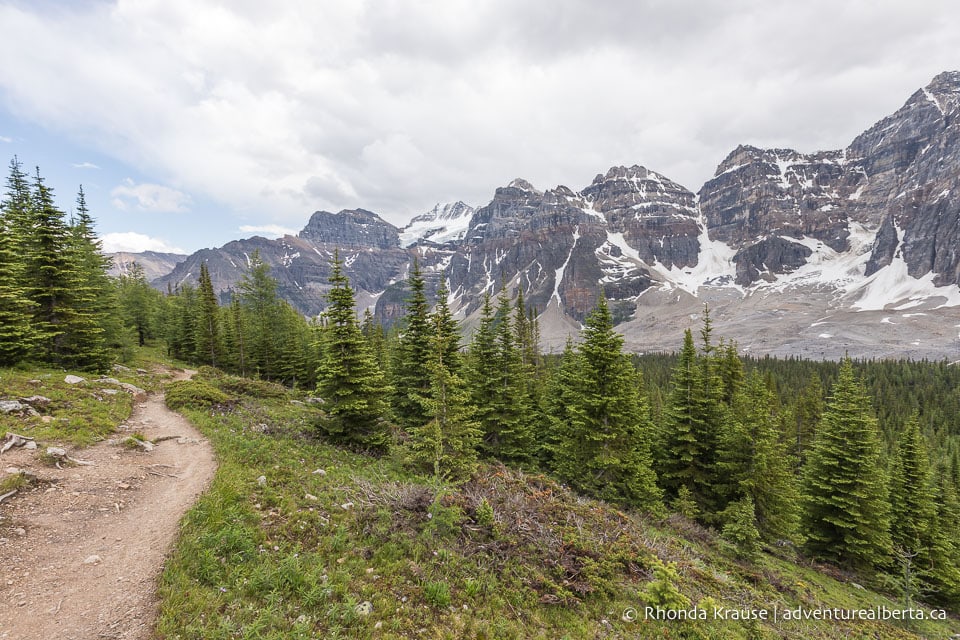
Review of the Eiffel Lake Hike
Eiffel Lake Trail is often overlooked in favour of more famous hikes in the Lake Louise- Moraine Lake region, but it shouldn’t be skipped if you want to experience close-up views of the Valley of the Ten Peaks.
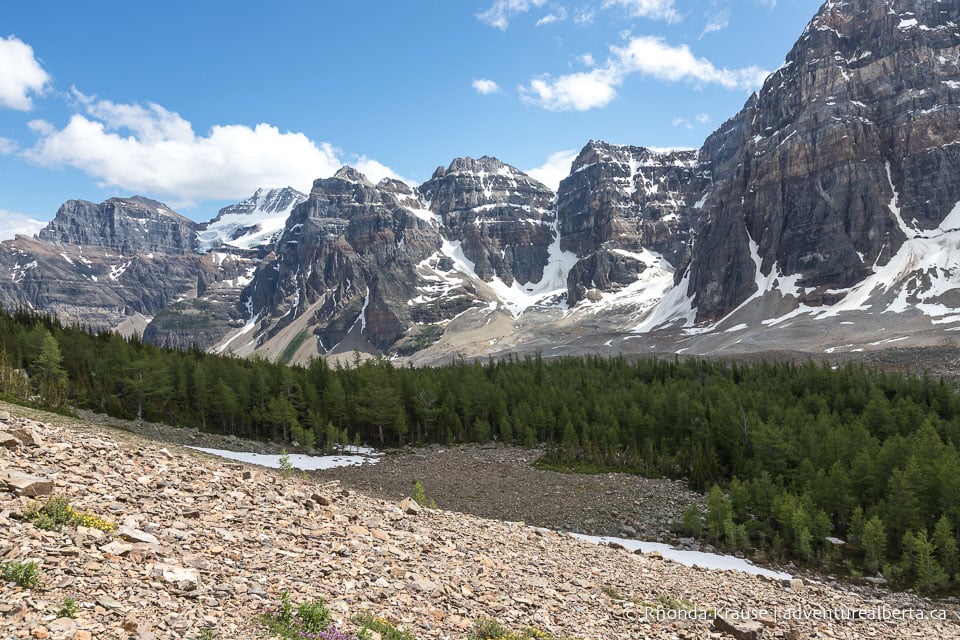
There’s plenty of scenic variety on the Eiffel Lake hike including forests, wildflowers, rocky peaks, glaciers, and talus slopes. The best part of the hike is when you exit the forest and walk along the valley’s edge because the Ten Peaks are visible all the way to Eiffel Lake.
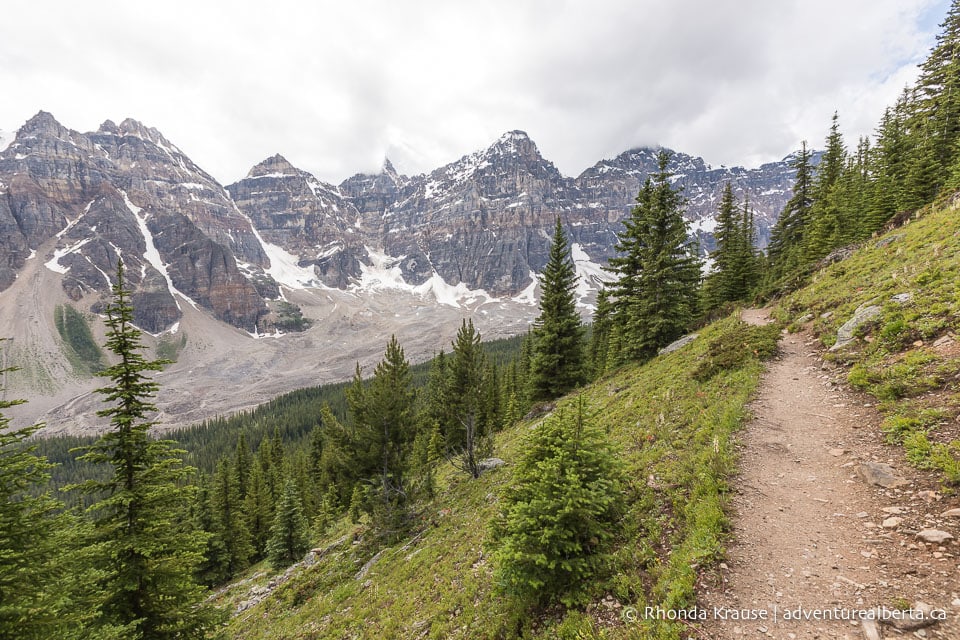
Another great thing about this hike is that it’s fairly easy after the switchbacks, so you get the most demanding part of the hike out of the way early on. This makes it easier to fully appreciate the views and stay alert for grizzly bears.

Even though the Eiffel Lake hike is only moderately difficult, that doesn’t mean you can embark on it without being prepared. The trail passes through grizzly habitat, has tripping hazards, and experiences changeable weather.

Pictures of Eiffel Lake Trail
Here are a few more pictures of the Eiffel Lake hike.

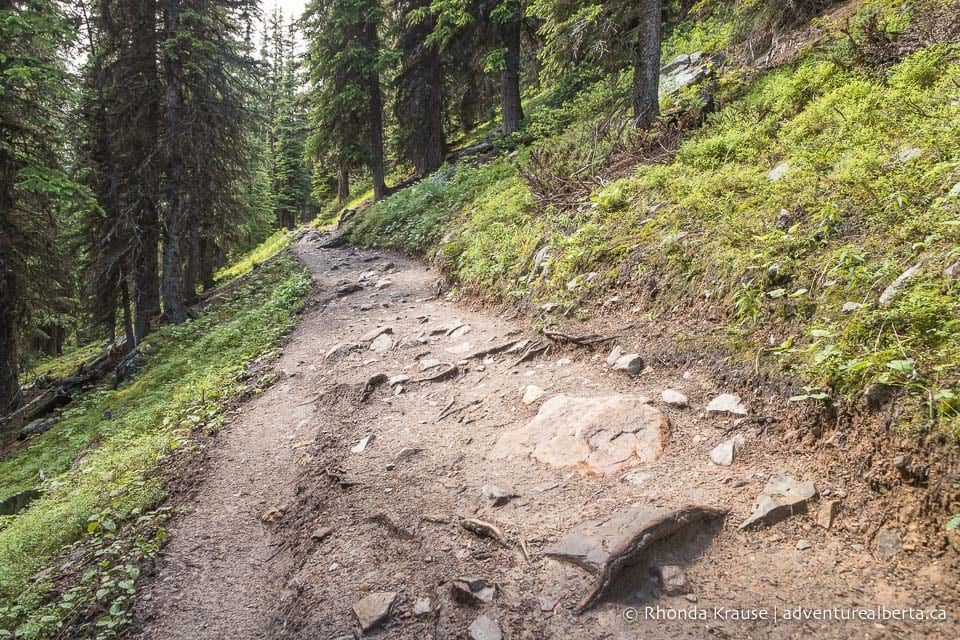
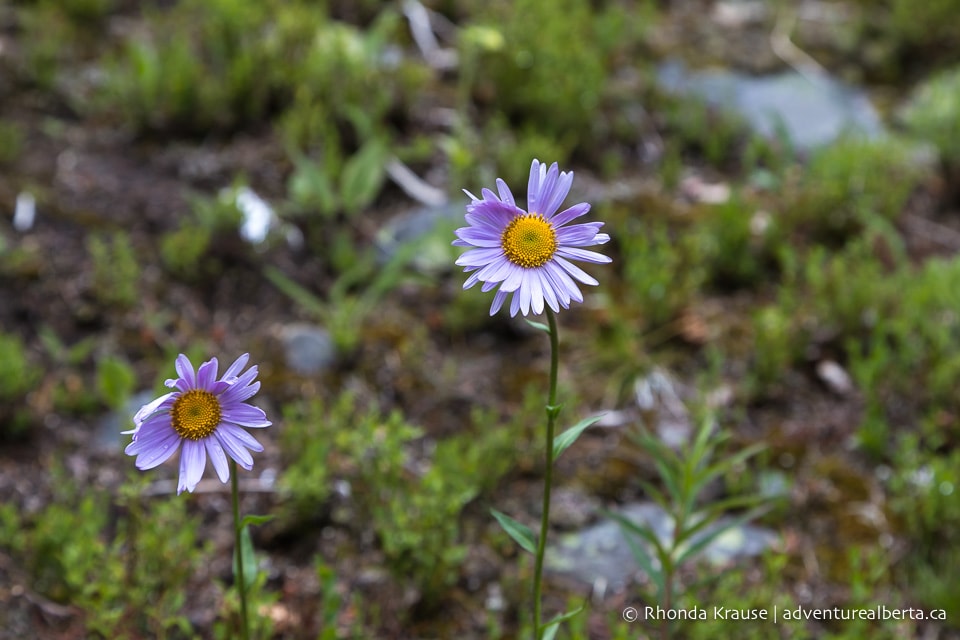








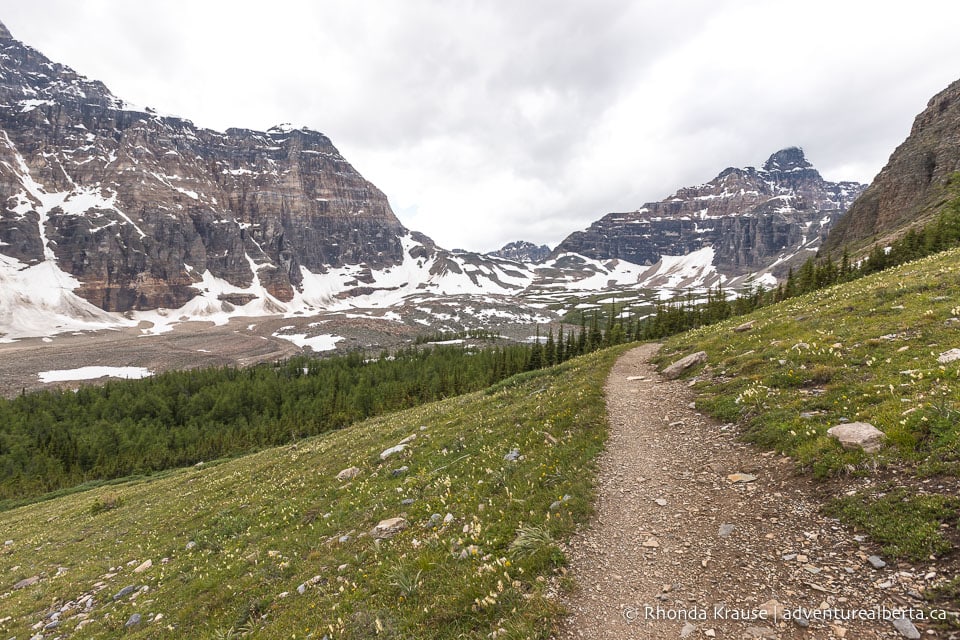

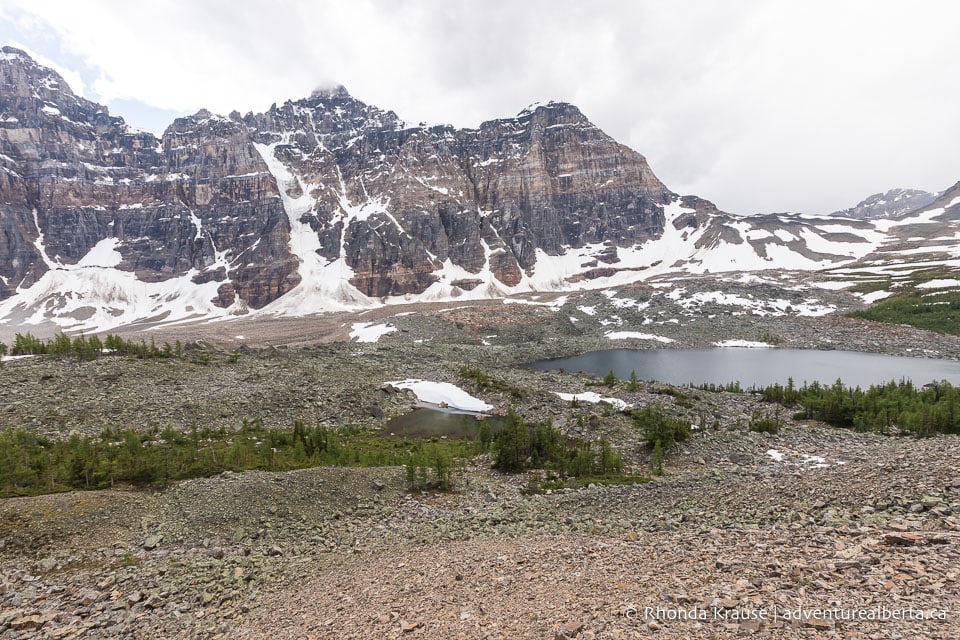

Tips for Hiking Eiffel Lake Trail
Location: Eiffel Lake Trail is located at Moraine Lake, 14 km south of the hamlet of Lake Louise in Banff National Park.
Getting to the Eiffel Lake Trailhead: Starting in 2023, Moraine Lake Road is closed to private vehicles year round. To get to Moraine Lake and the Eiffel Lake trailhead you have to take the Parks Canada shuttle or another public transportation option. Information about shuttles to Moraine Lake, including price, routes, schedules and how to make reservations, can be found on the Parks Canada Website.
- Moraine Lake Road is closed to all vehicles, including public transport, from early October (after the Canadian Thanksgiving weekend) to early June because of large snowfalls and avalanche risk
Parking at Moraine Lake: As mentioned, private vehicles are no longer allowed to park at Moraine Lake. An exception will be granted for people who have a disabled parking hang tag.
Best Time to Hike Eiffel Lake Trail: The Eiffel Lake hike is best done during summer in Banff National Park (July and August) and through late September, as long as most the trail is clear of snow and there is no longer any avalanche risk.
Facilities: There are outhouses across from the parking lot and the lodge has a café, restaurant, and gift shop.
Visitor Guidelines and Safety: Grizzly bears frequent this area so there may be trail restrictions in place. When group access is mandatory, by law you have to hike in a close group of four. Anyone not complying may be charged and issued a hefty fine up to $5,000. There is a sign at the trailhead indicating if group access is mandatory or recommended, but you can also check the Parks Canada website for updates.
- Bring bear spray and know how to use it.
- Stay on designated trails and don’t shortcut through the trees at the switchbacks.
- Leave no trace by carrying out all your garbage.
- Check the weather forecast, current trail conditions, and warnings and closures before heading out on your hike.
Gear and What to Bring: Sturdy hiking shoes with ankle support are recommended because of the rocky, uneven terrain in places. Hiking poles can take some stress off your knees when descending back to Moraine Lake.
- Dress in layers and bring rain gear because the weather can change quickly (and frequently) in the mountains.

Accommodations in Lake Louise
For your convenience, here is a list of hotels in Lake Louise. Please consider booking your Lake Louise accommodations through the included link. It costs nothing extra and helps support this website. Thank you!
Nearby Activities
You may also enjoy these other things to do near Lake Louise village:
Shop for Alberta & Adventure Themed Merchandise
Visit our store for more Alberta, nature, and adventure inspired products.






